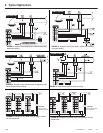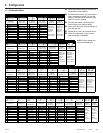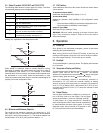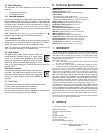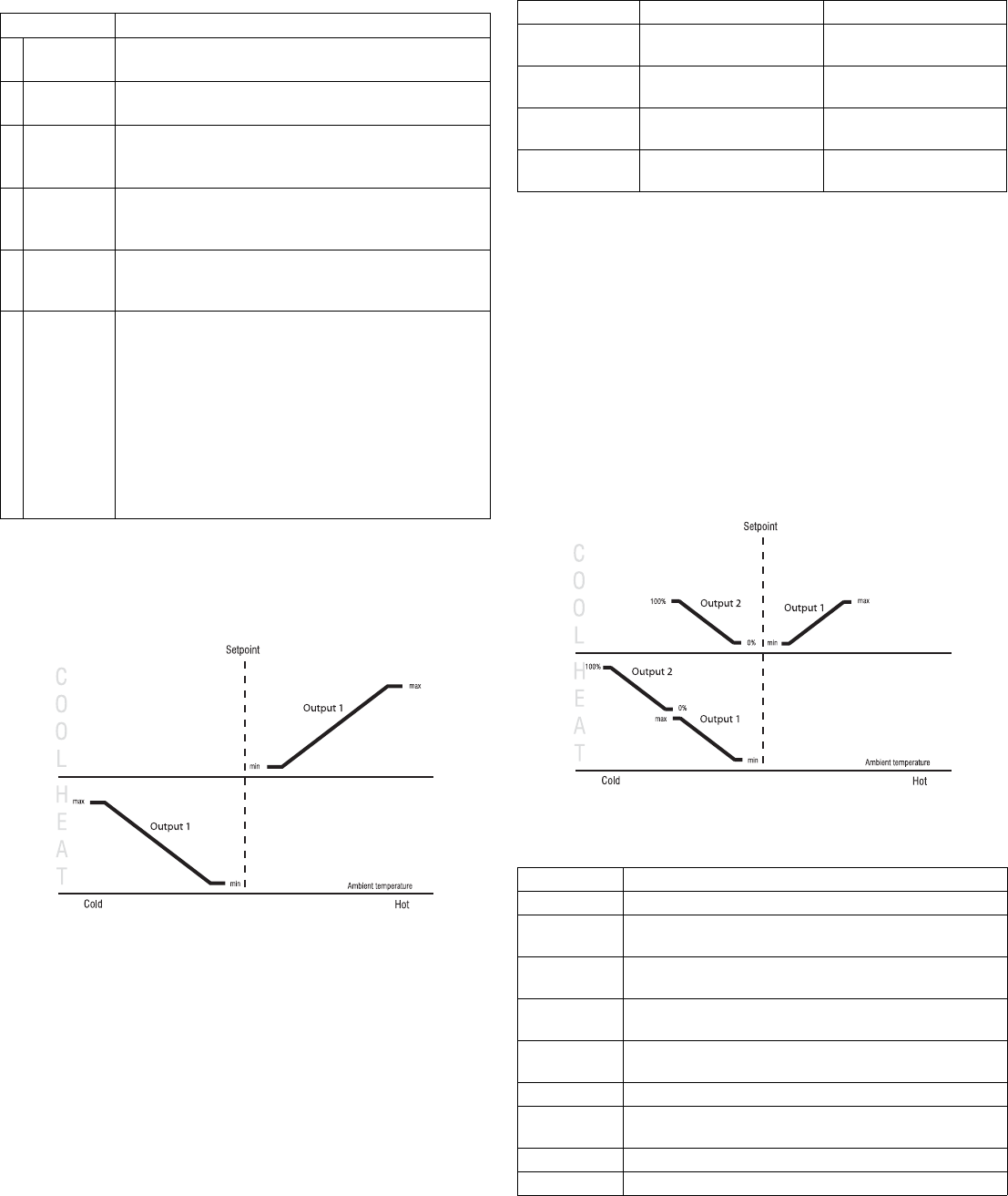
TH150 400-150-000-C 5/9/06 4/6
4.2 Application Types
The following table shows the different thermostat applications and
their corresponding settings in the configuration menu.
4.3 Output 1
Output 1 is used to control a damper. It controls heating when the
thermostat is in heat mode or cooling when the thermostat is in cool
mode.
Set the following configuration parameters:
• Default mode
• Output type (1A and 1A2T models only)
• Minimum opening
• Opening time (1F and 1F2T models only)
4.3.1 Default Mode / Output Type
The default mode (heat/cool) is used for the following:
• The default mode is the thermostat’s mode at power-up.
• The default mode is the active mode when the N.O. changeover
contact is open (see section 5.5.2).
• When configured as a contact (see section 4.5), Output 3 controls
either heating or cooling depending on whether the default mode
is set to heat or cool respectively.
The following table shows the different default modes, the different
output types for Output 1, and their corresponding settings in the
configuration menu.
4.3.2 Minimum Opening
The minimum damper opening can be set between 0 and 50 %.
Note: It is not recommended to set the minimum damper opening to
0 % (fully closed) when a duct heater is connected to Output 2 or 3.
4.3.3 Opening time (1F and 1F2T models only)
The damper opening time can be set between 80 and 160 seconds.
4.4 Output 2 (models TH150-1A2T and TH150-1F2T)
Output 2 controls heating only, regardless of the thermostat’s mode.
When the thermostat is in heat mode, Output 2 is activated as soon
as Output 1 reaches its full capacity. When the thermostat is in cool
mode, Output 2 is activated when the measured temperature drops
below the setpoint.
The following table shows the output types for Output 2 and their
corresponding settings in the configuration menu.
Note: If 0-4 is selected, set the SW6 switch to Triac. If 5-8 is
selected, set the switch to Analog (see section 4.7)
Menu setting Description
0
Internal
sensor
To control the ambient temperature using the internal
(built-in) sensor
1Room
To control the ambient temperature using the AC144-03
temperature sensor (the internal sensor is not used)
2 Air return
To control the temperature at the air return using the
AC146-410 temperature sensor (the internal sensor is
not used)
3 Air supply
To control the temperature at the fresh air supply using
the AC146-410 temperature sensor (the internal sensor
is not used)
4
Automatic
changeover
To control the ambient temperature using the internal
sensor. The AC146-410 temperature sensor is used for
automatic changeover. See section 5.5.1.
5
Limited
cooling
To use the outdoor air for cooling whenever possible.
The AC146-410 temperature sensor is used to measure
the outdoor air temperature. The internal temperature
sensor measures the room temperature which is then
compared with the setpoint. If the room temperature is
lower than the setpoint, the air intake damper remains
closed. If the room temperature is higher than the
setpoint, the latter is then compared with the outdoor
temperature. If the fresh air temperature is lower than
the setpoint by more than 3°C (5.4°F), the damper
opens to allow cool air in.
Menu setting 1A & 1A2T models 1F & 1F2T models
0
Cool / 0-10 V analog
(max. of 10 min. refresh)
Cool
(24 V tri-state floating)
1
Heat / 0-10 V analog
(max. of 10 min. refresh)
Heat
(24 V tri-state floating)
2
Cool / 2-10 V analog
(max. of 10 min. refresh)
3
Heat / 2-10 V analog
(max. of 10 min. refresh)
Menu setting Description
0 Not used
1
24 VAC pulsed (triac) / 1 sec. cycle
(e.g., 24 V SSR such as Aube’s RT850 or RT850T)
2
24 VAC pulsed (triac) / 10 min. cycle / direct action
(e.g., N.C. thermal valve)
3
24 VAC pulsed (triac) / 10 min. cycle / reverse action
(e.g., N.O. thermal valve)
4
24 VAC pulsed (triac) / 15 min. cycle (e.g., mechanical
relay such as Aube’s RC840 or RC840T)
5 0-10 V pulsed / 1 sec. cycle (e.g., 3-32 V SSR)
6
0-10 V analog / 1 sec. refresh
(e.g., SCR controlled device such as a re-heater)
7 0-10 V analog / max. of 10 min. refresh (e.g., valve)
8 2-10 V analog / max. of 10 min. refresh (e.g., damper)




